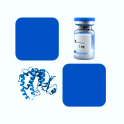
- Remove this product from my favorite's list.
- Add this product to my list of favorites.
Products
Newsletter
 |  |  |  |  |  |

Background
Cell surface glycoprotein CD200 receptor 1 is a protein that in humans is encoded by the CD200R1 gene. This gene encodes a receptor for the OX-2 membrane glycoprotein. Both the receptor and substrate are cell surface glycoproteins containing two immunoglobulin-like domains. This receptor is restricted to the surfaces of myeloid lineage cells and the receptor-substrate interaction may function as a myeloid downregulatory signal. CD200 and its receptor CD200R are both type-1 membrane glycoproteins, which are members of the immunoglobulin superfamily (IgSF). Besides the inhibitory effect on macrophages, CD200/CD200R also play an important role in regulating the regulatory T cells, allergicreaction, autoimmune diseases, allograft, neurological diseases and other autoimmune-related diseases. The interaction between CD200, which is mainly present in neurons but also in astrocytes, and CD200R1, which is mainly present in microglia, is one of the mechanisms involved in keeping the microglial proinflammatory phenotype under control in physiological conditions. Alterations in the expression of CD200 and CD200R1 have been described in neurodegenerative diseases, but little is known about the mechanism of regulation of these proteins under physiological or pathological conditions.
Source
Recombinant Biotinylated Human CD200 R1, Fc,Avitag (CR2-H82F4) is expressed from human 293 cells (HEK293). It contains AA Ala 27 - Leu 266 (Accession # AAQ19772.1).
Predicted N-terminus: Ala 27
Molecular Characterization
This protein carries a human IgG1 Fc tag at the C-terminus, followed by a Avi tag (Avitag™).
The protein has a calculated MW of 55.8 kDa. The protein migrates as 70-115 KDa under reducing (R) condition (SDS-PAGE) due to glycosylation.
Biotinylation
Biotinylation of this product is performed using Avitag™ technology. Briefly, the single lysine residue in the Avitag is enzymatically labeled with biotin.
Biotin:Protein Ratio
Passed as determined by the HABA assay / binding ELISA.
Endotoxin
Less than 1.0 EU per μg by the LAL method.
Purity
>95% as determined by SDS-PAGE.
Formulation
Lyophilized from 0.22 μm filtered solution in Tris with Glycine, Arginine and NaCl, pH7.5. Normally trehalose is added as protectant before lyophilization.
Reconstitution
Please see Certificate of Analysis for specific instructions.
For best performance, we strongly recommend you to follow the reconstitution protocol provided in the CoA.
Storage
For long term storage, the product should be stored at lyophilized state at -20°C or lower.
Please avoid repeated freeze-thaw cycles.
This product is stable after storage at:
-20°C to -70°C for 12 months in lyophilized state;
-70°C for 3 months under sterile conditions after reconstitution.
Bioactivity
Please refer to product data sheet.
(1) "Comprehensive Profiling of Inflammatory Factors Revealed That Growth Differentiation Factor-15 Is an Indicator of Disease Severity in COVID-19 Patients"
Teng, Zhang, Shi et al
Front Immunol (2021) 12, 662465
(2) "Upregulated CD200 in pre-retinal proliferative fibrovascular membranes of proliferative diabetic retinopathy patients and its correlation with vascular endothelial growth factor"
Hu, Xie, Cheng
Inflamm Res (2019) 68 (12), 1071-1079
(3) "Characterization of CD 200-receptor expression in the murine epidermis"
Rosenblum, Woodliff, Madsen et al
J Invest Dermatol (2005) 125 (6), 1130-8
Showing 1-3 of 6 papers.
Follow us